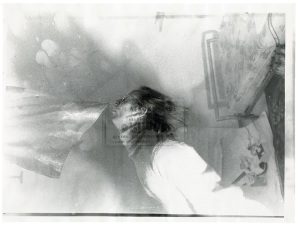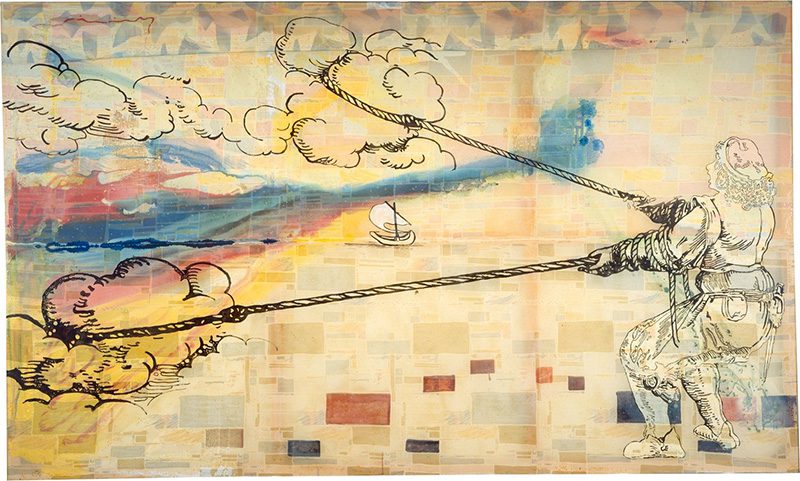TRACES: Sigmar Polke
 Today is the occasion to bear in mind Sigmar Polke (13/2/1941-10/6/2010), he is an artist whose work defies easy definitions. He is one of the most significant painters of the post-war generation, yet his career has by no means been confined to painting. Polke’s artistic diversity, and his resistance to any form of categorisation, has been seen as the only consistent theme in his work. This column is a tribute to artists, living or dead, who have left their mark in Contemporary Art. Through documents or interviews, starting with: moments and memories, we reveal out from the past-unknown sides of big personalities, who left their indelible traces in time and history…
Today is the occasion to bear in mind Sigmar Polke (13/2/1941-10/6/2010), he is an artist whose work defies easy definitions. He is one of the most significant painters of the post-war generation, yet his career has by no means been confined to painting. Polke’s artistic diversity, and his resistance to any form of categorisation, has been seen as the only consistent theme in his work. This column is a tribute to artists, living or dead, who have left their mark in Contemporary Art. Through documents or interviews, starting with: moments and memories, we reveal out from the past-unknown sides of big personalities, who left their indelible traces in time and history…
By Efi Michalarou
 Born in German-occupied Poland in 1941, Polke’s family fled to East Germany in 1945 as part of the expulsion of Germans in the area in 1945, only to then escape to West Germany in 1953. From 1961 to 1967 he studied at the Düsseldorf Arts Academy under Karl Otto Götz, Gerhard Hoehme and deeply influenced by his teacher Joseph Beuys. He began his creative output during a time of enormous social, cultural, and artistic changes in Germany and elsewhere. In 1963 Polke organised an exhibition with fellow students Gerhard Richter and Konrad Lueg called “Capitalist Realism”. The exhibition was mockingly titled after the realist style of art known as “Socialist Realism”, then the official art doctrine of the Soviet Union, but it also commented upon the consumer-driven art ”doctrine” of western capitalism. He also participated in “Demonstrative Ausstellung”, a store-front exhibition in Düsseldorf with Manfred Kuttner, Lueg, and Richter. Essentially a self-taught photographer, Polke spent the next three years painting, experimenting with filmmaking and performance art. Polke’s early work has often been characterised as European Pop art for its depiction of everyday subject matter: sausages, bread and potatoes, combined with images from the mass media. But in contrast to the slick and polished style of American Pop, Polke’s early drawings have a childlike clumsiness which implies an ironic attitude both to the culture of commodity worship and the issue of ‘appropriate’ subject matter for art. Parallels with mainstream Pop art are also visible in Polke’s paintings which imitate the dotted effect of commercial printing techniques. In “Girlfriends” (1965), Polke challenges the authority of the printed image by exaggerating the mishaps and unreliability of the mechanical process: colours are ‘off-register’ and the dots blur together into abstract, meaningless patterns. During this period Polke also began to use commercially-produced fabrics instead of canvas, incorporating the printed patterns into the composition of the painting. By combining these different styles and techniques, Polke unpicks and exposes the codes and structures of image-making, asking the viewer to question traditional methods of evaluating art. In the ‘70s Polke explored the relationship between photography and painting, and developed his interest in challenging the objectivity of the photographic image. In 1974 he travelled in Pakistan and Afghanistan, using his photographs from this trip as the basis for a number of manipulated photographic and painted works. These explore questions of authenticity, reproduction, imitation and authorship, harking back to his ironic statements in the early 1960s that he was guided by ‘Higher Powers’ to produce paintings. Polke also began to make large, gestural paintings which combined figurative and abstract imagery. During the ‘80s he experimented with materials and chemicals, mixing together traditional pigments with solvents, varnishes, toxins and resins to produce spontaneous chemical reactions. These experiments produced elaborate abstract paintings which reflect on the concepts of originality and authorship which underpin the Modernist tradition and, in particular, the mystique of American Abstract Expressionism. In the last two decades Polke has made a number of works which have been described as “allegorical history paintings”. These groups of works often respond to the site in which they are shown, weaving together local references with broader reflections on politics, culture and image-making. The Hunting Tower series of 1984-88 features a recurring image of the typical observation points once placed in concentration camps or along the Berlin wall. Typical of Polke’s complex layering of ideas, these works reflect on both Germany history and the process of looking, perceiving and observing which is at the heart of image-making. In recent years Polke has continued to experiment with new styles and techniques, creating richly allusive works which reinvent the practice of painting. From 1977–1991, he was a professor at the Academy of Fine Arts, Hamburg. He settled in Cologne 1978, where he continued to live and work until his death after a long battle with cancer.
Born in German-occupied Poland in 1941, Polke’s family fled to East Germany in 1945 as part of the expulsion of Germans in the area in 1945, only to then escape to West Germany in 1953. From 1961 to 1967 he studied at the Düsseldorf Arts Academy under Karl Otto Götz, Gerhard Hoehme and deeply influenced by his teacher Joseph Beuys. He began his creative output during a time of enormous social, cultural, and artistic changes in Germany and elsewhere. In 1963 Polke organised an exhibition with fellow students Gerhard Richter and Konrad Lueg called “Capitalist Realism”. The exhibition was mockingly titled after the realist style of art known as “Socialist Realism”, then the official art doctrine of the Soviet Union, but it also commented upon the consumer-driven art ”doctrine” of western capitalism. He also participated in “Demonstrative Ausstellung”, a store-front exhibition in Düsseldorf with Manfred Kuttner, Lueg, and Richter. Essentially a self-taught photographer, Polke spent the next three years painting, experimenting with filmmaking and performance art. Polke’s early work has often been characterised as European Pop art for its depiction of everyday subject matter: sausages, bread and potatoes, combined with images from the mass media. But in contrast to the slick and polished style of American Pop, Polke’s early drawings have a childlike clumsiness which implies an ironic attitude both to the culture of commodity worship and the issue of ‘appropriate’ subject matter for art. Parallels with mainstream Pop art are also visible in Polke’s paintings which imitate the dotted effect of commercial printing techniques. In “Girlfriends” (1965), Polke challenges the authority of the printed image by exaggerating the mishaps and unreliability of the mechanical process: colours are ‘off-register’ and the dots blur together into abstract, meaningless patterns. During this period Polke also began to use commercially-produced fabrics instead of canvas, incorporating the printed patterns into the composition of the painting. By combining these different styles and techniques, Polke unpicks and exposes the codes and structures of image-making, asking the viewer to question traditional methods of evaluating art. In the ‘70s Polke explored the relationship between photography and painting, and developed his interest in challenging the objectivity of the photographic image. In 1974 he travelled in Pakistan and Afghanistan, using his photographs from this trip as the basis for a number of manipulated photographic and painted works. These explore questions of authenticity, reproduction, imitation and authorship, harking back to his ironic statements in the early 1960s that he was guided by ‘Higher Powers’ to produce paintings. Polke also began to make large, gestural paintings which combined figurative and abstract imagery. During the ‘80s he experimented with materials and chemicals, mixing together traditional pigments with solvents, varnishes, toxins and resins to produce spontaneous chemical reactions. These experiments produced elaborate abstract paintings which reflect on the concepts of originality and authorship which underpin the Modernist tradition and, in particular, the mystique of American Abstract Expressionism. In the last two decades Polke has made a number of works which have been described as “allegorical history paintings”. These groups of works often respond to the site in which they are shown, weaving together local references with broader reflections on politics, culture and image-making. The Hunting Tower series of 1984-88 features a recurring image of the typical observation points once placed in concentration camps or along the Berlin wall. Typical of Polke’s complex layering of ideas, these works reflect on both Germany history and the process of looking, perceiving and observing which is at the heart of image-making. In recent years Polke has continued to experiment with new styles and techniques, creating richly allusive works which reinvent the practice of painting. From 1977–1991, he was a professor at the Academy of Fine Arts, Hamburg. He settled in Cologne 1978, where he continued to live and work until his death after a long battle with cancer.










